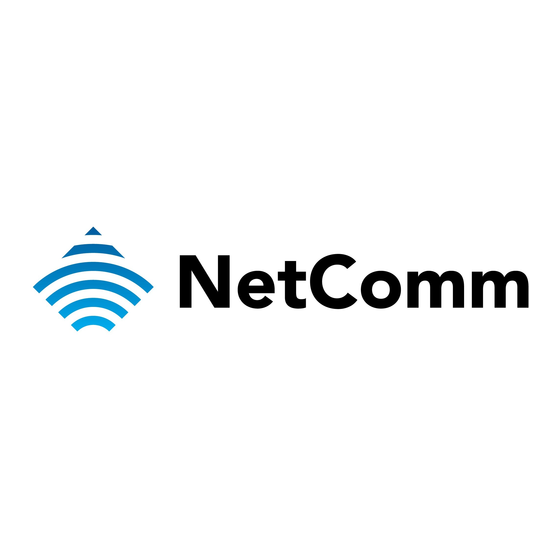
Table of Contents
Advertisement
Quick Links
Advertisement
Table of Contents

Summary of Contents for NetComm HS1100N
- Page 1 Wireless N Hotspot Quick Start Guide...
-
Page 2: Revision History
Change List 1.0—May 2011 Initial Document Release The feature-rich NetComm Wireless N Hotspot HS1100N enables any business or office environment to set up a hotspot location offering a wireless Internet connection for up to 100 users at a time. Package Contents The following items should be included in your HS1100N package. -
Page 3: System Overview
Press to start the WES (WDS Easy Setup) process. Reserved for future use. Rear Panel Item Description Antenna Connectors Attach the included WiFi antennas here. (The HS1100N offers 1 WiFi interface with 2 SMA connectors) HS1100N Quick Start Guide YML-QSG-HS... -
Page 4: Top Panel
Top Panel The following indicator lights (LEDs) provide a quick way to check the current status of the HS1100N. Icon Item Description Power LED on – Power is being supplied to the HS1100N LED off – The HS1100N is not powered on LED on –... -
Page 5: Hardware Installation
Please follow the steps mentioned below to install the HS1100N. 1. Place the HS1100N in the best location possible. The best location for the HS1100N is usually at the centre of your wireless network. This ensures it is able to get a clear wireless signal. -
Page 6: Getting Started
Getting Started The HS1100N offers a web based configuration page. After completing the hardware installation above, the HS1100N can be configured through a computer by utilising a web browser with JavaScript enabled. The default LAN IP addresses are: LAN1: 192.168.110.1 – This is mapped to the Private Zone; User authentication is required to access network resources. -
Page 7: Configuration Steps
Configuration Steps Once the hardware installation steps are complete, please follow the appropriate setup steps for using DHCP in your operating system. The HS1100N will then be able to automatically assign an IP address to the computer or connected device. -
Page 8: Windows Vista
Double click on “Internet Protocol Version 4 (TCP/IPv4)”. Check “Obtain an IP address automatically” and “Obtain DNS server address automatically” then click on “OK” to continue. Click on “OK” to complete the network configuration procedure. HS1100N Quick Start Guide YML-QSG-HS... - Page 9 Wireless N Hotspot – HS1100N Windows 7 Click on “Start” -> “Control Panel” (in Category View) -> “View network status and tasks”. In the Control Panel Home, click on “Change adapter settings” on the left hand side of the window to continue.
-
Page 10: Mac Os X
Click on the Apple menu and click on “System Preferences”. Click on the “Network” icon. Set “Location” to Automatic. Click on the “Ethernet” item in the list on the left hand side. In the “Configure IPv4” section, choose “Using DHCP” Click on “Apply”. HS1100N Quick Start Guide YML-QSG-HS... - Page 11 Wireless N Hotspot – HS1100N Open your web browser and type http://192.168.110.1 into the address bar at the top of the page. The following Login page should then be displayed. Type “Admin” into both the username and password fields and click the “Login” button.
-
Page 12: Common Settings
Common Settings Setup Wizard The HS1100N provides a “Setup Wizard” for quick and easy configuration. Click on the “Setup Wizard” button to start the configuration process. HS1100N Quick Start Guide YML-QSG-HS... - Page 13 Wireless N Hotspot – HS1100N Step 1: General Step 1 of the setup wizard enables you to configure your Administrator password, System Time settings and the web page address connected computers are redirected to. Enter a new administrator password in the “New Password” field and then re-enter the same new password in the “Verify Password”...
- Page 14 WAN device (such as an ADSL modem or 3G router). Dynamic: Network configuration information is automatically obtained via DHCP from your WAN device (such as an ADSL modem or 3G router). PPPoE: Enter the username and password required to connect to your WAN service. HS1100N Quick Start Guide YML-QSG-HS...
- Page 15 Please note: A maximum of 32 characters is allowed for the ESSID. Please note: The HS1100N supports two Virtual Access Points (VAP), one under a Public zone (Default Setting: NetComm_HS1100N) and one under a Private zone (Default Setting: NetComm_HS1100N_2). The ESSID for the Private zone is not broadcast.
- Page 16 To disable authentication, click the “Disable” radio button. Please note: When authentication is enabled, a default authentication server must be selected. The HS1100N supports 4 types of authentication server – Local, Radius (x 2) and On Demand. By default, On- demand is selected.
- Page 17 Wireless N Hotspot – HS1100N Server 3 (RADIUS): When specifying a Radius authentication server, select the appropriate security policy to apply to the user account and enter the Radius server address, the Radius authentication port, the Radius accounting port as provided by your Radius server administrator.
- Page 18 You should then see the following page: After you have printed out the ticket generated or noted down the username and password, close the “On-demand User Receipt” window and click the “Next” button. HS1100N Quick Start Guide YML-QSG-HS...
- Page 19 A “Confirm and Restart” message will show on the page while the HS1100N is restarting. Do not unplug the system during this process. Please note: The HS1100N is attempting to contact your chosen DNS server during this period. A longer start up time may occur if the chosen DNS cannot be contacted.
-
Page 20: User Login
“Submit”. The Login Success page should then be displayed as per the screen shot below. This indicates the client has logged in successfully and that the HS1100N has been correctly configured. Please note: The format of a full (valid) username is userid@postfix, where “userid” is the username of the account created and “postfix”...













Need help?
Do you have a question about the HS1100N and is the answer not in the manual?
Questions and answers